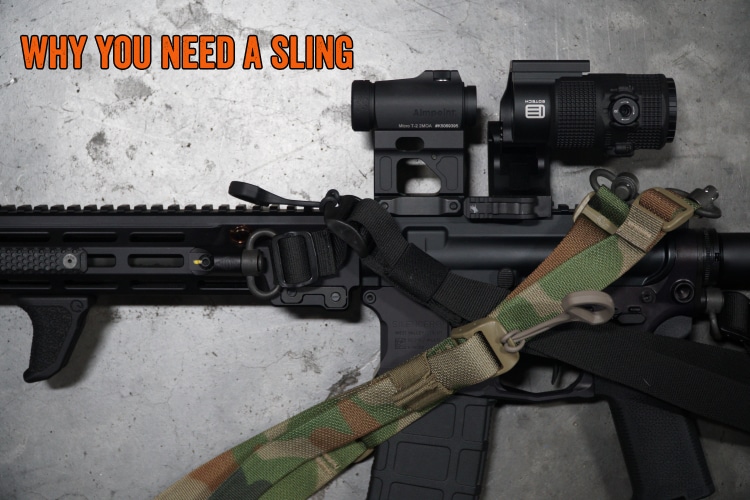
Should You Carry With A Round Chambered?
Explore carrying with a round chambered with True Shot Academy. Learn the benefits of carrying with a round in the chamber and more.

Hey all, we here at True Shot Academy are going to go over slings and why you should run one. We are going to provide a brief overview of slings while delving into their benefits and traits. We will also cover use cases and different types of slings on the market. Without further ado, let’s get into it.
A sling provides a shooter with multiple advantages. Obviously, a sling allows a user to sling a firearm on their body, freeing up their hands. Firearms can be slung on the shoulder or across the body very easily. Slings can also be used to help a shooter stabilize a a firearm when shooting. This benefit can be observed on everything from subguns to rifles. Traditional slings in the past featured a way for a shooter to cinch the sling down around their arm to further promote stability. Slings can also be used to free up a shooter’s hands and allow them to perform other tasks. This is particularly useful for those in the field or austere conditions. Slings can also be stored onboard the firearm in a staged position or removed completely when not in use. Slings don’t take up much space when set up properly and can be employed quickly when the need arises. Essentially, a sling is a versatile piece of equipment which will aid the shooter in a variety of ways.
Slings can effectively be utilized by a variety of end users. Hunters can utilize slings to comfortably retain their rifle and free up their hands for tasks such as cleaning and carrying game. Those wishing to train with their ARs and other tactical rifles can utilize slings when working on transitioning from rifle to pistol. An important benefit yielded when using a sling is firearm retention. Simply put, a sling tethers a firearm to the body and prevents it from easily being taken away. This benefit is especially relevant to armed professionals. Slings are also an invaluable tool among hunters and those who are out in the field with their firearms. These types of end users can sling their rifles to reduce fatigue and free up one’s hands for other tasks.
Slings will most commonly be found in one of these three types.
Slings can be mounted in a variety of methods. Most slings will come from the manufacturer able to accept a litany of attachment methods. Some slings will come with mounting hardware permanently attached, preventing an end user from swapping hardware.
Slings are typically attached to firearms using any combination of the following. Some slings only rely on a single attachment point while others utilize more. These sling mounting methods are some of the most common methods one will encounter.
One can acquire quality slings from a wide variety of manufacturers. Companies such as Magpul, Haley Strategic Partners, Blue Force Gear, and Edgar Sherman Design are among those who provide slings. These four companies are just a drop in the bucket when it comes to those who manufacture slings. At this point in time, there are many quality slings on the market, making it easy for an end user to pick up a reliable piece of kit.
All in all, a sling is an essential piece of kit which is of great benefit to shooters. A sling can be easily added to one’s firearm and removed in a moment’s notice if so desired. The versatility and benefits of a sling will be felt by shooters whether they are using a rifle, shotgun, or even a subgun. Enhance your firearm and set yourself up with a sling today. As always, happy shooting.
Need bulk ammo? At True Shot Ammo, we have a wide variety of handgun ammo and rifle ammo available to purchase. Please visit our website trueshotammo.com, call us at (888) 736-6587, or you can email us at [email protected] for more ammo options.
View more posts about gear:

Explore carrying with a round chambered with True Shot Academy. Learn the benefits of carrying with a round in the chamber and more.

Explore SBR considerations with True Shot Academy. Learn what an SBR is, how you can legally get one, their pros and cons, and more.

Discover the disposable nature of magazines with True Shot Academy. Learn about why they wear, how to keep your magazines going, and more.